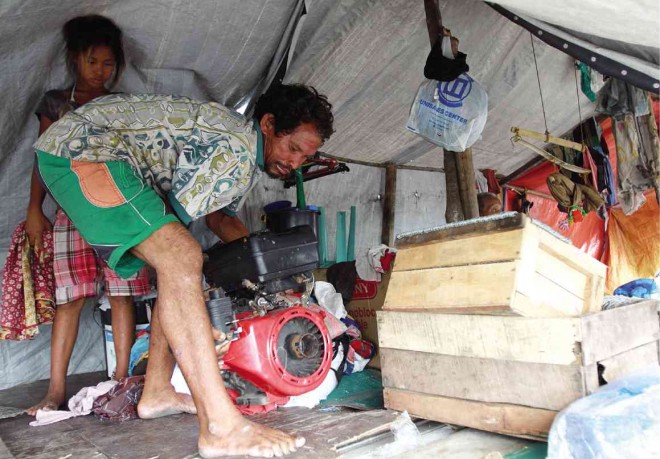Hazy plans keep Zamboanga City evacuees in limbo

A MEMBER of the Badjao tribe keeps his boat engine in a tent city that was initially put up for tribe members displaced by the terror attack by Misuari’s men in Zamboanga City and the government armed response to it. Most of the Badjaos in the temporary shelter have since been uprooted and relocated to an area far from their source of livelihood, the sea. EDWIN BACASMAS
ZAMBOANGA CITY—The confusion over what the government intends to do with hundreds of residents here who had been displaced nearly a year ago by a terror attack and the government’s armed response is testing the patience of evacuees and the head of a United Nations agency helping bring normalcy back to the residents’ lives.
Eleven months after armed followers of Moro leader Nur Misuari marched on the city streets and took over several villages and government responded by firing away, residents living in what were supposed to be temporary shelters said they are in limbo.
“We’re still in the dark,” said evacuee Nurfaisa Mandangan, a 31-year-old mother of four, in an interview.
‘Never-ending struggle’
Mandangan and her children have been staying at the grandstand of the Don Joaquin F. Enriquez Memorial Sports Complex, which had been converted into an evacuation center, for nearly a year now.
“It’s a never-ending struggle for us,” said Mandangan. “My children get sick,” she added.
Gamal Hassan, an evacuee from the village of Mariki and a founding member of “No To Relocation Movement,” said residents are in limbo.
Hazy information
“We don’t have any clear information on when this so-called rehabilitation (program) will be implemented,” Hassan said.
Some evacuees, like those from the villages of Sta. Catalina and Zone 4, had received permanent housing units.
But people from the villages of Rio Hondo and Mariki are still in evacuation centers and so-called transition sites.
Place of origin
Peter Deck, head for Mindanao of the United Nations High Commissioner for Refugees (UNHCR), said government action on the evacuees’ situation seems to be heading the wrong way.
“We are talking 11 months later and still the discussion focuses more on where we could temporarily relocate people instead of how we could find them a permanent, durable solution,” Deck said.
He said, ideally, evacuees should be returned to their places of origin. “Where they were living before is the best place because then they have less need for help,” said Deck.
No solution
Putting evacuees in a temporary resettlement area is “not a durable solution,” he said.
“You just relocate but you are not improving their situation,” he said.
Deck also questioned the local government’s “no build, no return zone” policy, especially in the villages of Mariki, Rio Hondo and in the two island communities of Layag-Layag and Leha-Leha in Talon-Talon.
The policy, he said, is “confusing.” He said officials here justified the policy by saying it is consistent with the National Integrated Protected Areas (Nipas) Act, which prohibits settlements in protected areas. But it turned out to be false.
“The DENR has not designated these places as protected areas and [these are] not considered as hazard zone,” said Deck.
‘Restorative stage’
He said the reason “for not letting people return [to their places of origin] is unclear.” “Here we are, almost a year later, and there are still people in evacuation centers,” he said.
Zenaida Arevalo, regional director of the Department of Social Welfare in Western Mindanao, said the government is still on the “restorative stage” in this city.
Arevalo said officials could not move evacuees quickly out of the shelters because of several factors, among them the absence of land.
According to Arevalo, at least 15,131 evacuees are still in supposedly temporary shelters in the city. Julie S. Alipala, Inquirer Mindanao














